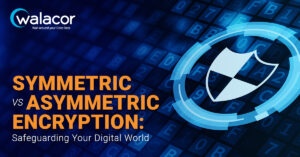Quantum-safe encryption, also known as post-quantum cryptography, is a topic of growing importance in cybersecurity. As we advance in the era of quantum computing, traditional cryptographic methods face the risk of being rendered obsolete by the sheer computational power of quantum machines. In this post, we’ll examine the significance of quantum-safe encryption, exploring what quantum computing poses as a threat to current encryption methods and how researchers are working toward developing secure alternatives.
Classical Encryption vs. Shor’s Algorithm
To comprehend the impact of quantum computing on encryption, it’s essential to understand the basics of how encryption works. Classical encryption relies on mathematical problems that are hard to solve, making it computationally infeasible for adversaries to decipher the encrypted information without the corresponding key. These problems include factoring large numbers and computing discrete logarithms, which are believed to be hard for classical computers.
However, quantum computers work entirely differently and leverage the principles of quantum mechanics to perform certain types of calculations exponentially faster than classical computers. One of the most renowned algorithms threatening traditional encryption in the age of quantum computing is Shor’s algorithm. Shor’s algorithm has the capability to factor large numbers efficiently and solve discrete logarithm problems, essentially breaking widely used cryptographic schemes like RSA and ECC (Elliptic Curve Cryptography).
Asymmetric vs Symmetric Encryption
To better understand the threat Shor’s algorithm poses, a brief introduction to asymmetric versus symmetric is helpful. Symmetric encryption utilizes a single shared key for both encryption and decryption. This ensures a faster process but requires secure key distribution. On the other hand, asymmetric encryption involves a pair of keys, public and private, offering a more secure communication method but at the cost of computational computing. Simply put, in encryption’s math problems, asymmetric methods allow for multiple answers to the same math problem, whereas only one answer exists in symmetric methods. Therefore, the vulnerability posed by quantum computing primarily targets asymmetric encryption methods, including Shor’s algorithm.
A useful – and potentially the best – example of symmetric encryption is the Advanced Encryption Standard (AES). AES is a symmetric encryption algorithm widely adopted for its efficiency and security. Unlike asymmetric algorithms, which rely on mathematical problems susceptible to quantum attacks, the security of AES stems from the difficulty of reversing its operations. As a result, AES is considered quantum-safe, offering a robust solution for safeguarding data in the quantum era.
A Quantum-Safe Encryption Response
The looming threat of Shor’s algorithm has prompted the need for additional quantum-safe encryption methods. The goal is to develop cryptographic algorithms that remain secure even in the face of quantum computing capabilities. IBM’s Quantum Roadmap reveals that Quantum Volume, the measure of quantum computing performance, has been doubling annually. Researchers are exploring various approaches to achieve this, and some of the leading candidates include lattice-based cryptography, hash-based cryptography, and code-based cryptography.
Lattice-based cryptography relies on the difficulty of certain mathematical problems related to lattice theory. Lattices are geometric structures that have proven to be quantum attack resistant. The complexity of finding short vectors in a lattice forms the basis of cryptographic security in this approach. Lattice-based cryptography is considered a promising candidate for post-quantum security due to its resilience against quantum attacks. NIST’s post-quantum cryptography standards recognize lattice-based schemes as potential candidates.
On the other hand, Hash-based cryptography relies on the properties of cryptographic hash functions. These functions are designed to be quantum-resistant, as breaking them would require solving mathematical problems believed to be challenging even for quantum computers. The Merkle signature scheme is an example of a hash-based cryptographic scheme being explored for post-quantum security.
In code-based cryptography, the cryptographic primitive utilizes error-correcting codes. As exemplified by the McEliece cryptosystem, code-based cryptography relies on the difficulty of decoding random linear codes. This difficulty provides an additional level of security against quantum attacks.
Transitioning to Quantum-Safe Encryption
While these approaches show promise, the transition to quantum-safe encryption is not without its challenges. Implementing new cryptographic algorithms requires extensive testing and validation to ensure their security and efficiency. Moreover, the transition needs to be smooth to avoid vulnerabilities during the coexistence of traditional and quantum-safe encryption systems.
Another aspect to consider is the impact on existing infrastructure. Many systems and protocols currently in use utilize traditional cryptographic algorithms. Migrating to quantum-safe encryption may require substantial changes to these systems, posing logistical and economic challenges. Organizations globally are working toward establishing quantum-safe standards to meet these challenges. The European Telecommunications Standards Institute (ETSI) created a working group focused on the “practical implementation of quantum-safe primitives, including performance considerations, implementation capabilities, protocols, benchmarking, and practical architectural considerations.” [Source]
Despite the challenges, the urgency of developing and adopting quantum-safe encryption cannot be overstated. A study by Gartner predicts that by 2025, 20% of organizations will budget for quantum-safe cryptography to prepare for the potential risks posed by quantum computing. The likely advent of large-scale quantum computers poses a serious threat to the confidentiality and integrity of sensitive information. Governments, industries, and organizations must proactively prepare for the post-quantum era to safeguard their data and communications.
Conclusion
Quantum-safe encryption is a crucial area of research and development in response to the looming threat of quantum computing on traditional cryptographic methods. The efforts to design and implement quantum-resistant algorithms are essential for ensuring the long-term security of sensitive information. As we navigate the complexities of this transition, collaboration between researchers, industries, and policymakers becomes paramount to establishing a robust and secure foundation for the future of encryption in the quantum era.
When Walacor was designing the encryption used in our product, we understood the threat that quantum computing posed. For this reason, we chose to only use symmetric encryption. We then took it further by using a separate key for every item we protect. While this is currently the best available solution, we also understand this is a quickly changing landscape. Therefore, we also built in the ability to quickly adapt to what the future may bring. We are currently focusing on Encryption Agility, which is the ability to re-encrypt existing items with new algorithms as they become available with minimal impact on a production system.



